

This is because when teenagers are developing an identity independent from their parents and family, they tend to be rebellious and are generally more difficult to manage. Therefore, during this transitional phase of growth and development, it is recommended that teenagers receive clear guidelines from their parents about what is and is not acceptable behaviour.
I have created the following resource guide to help parents facilitate a deeper understanding of reinforcement and punishment in behavioural psychology, and illustrate how parents can adopt these approaches to manage the behaviours of their teenage children.
There are several parts to this resource guide. I will first explain the operant conditioning theory of learning in behavioural psychology, definitions and types of reinforcement and punishment, use of reinforcement and punishment in influencing teenage behaviour, and finally compare the effectiveness of both approaches and what it means for parents.
What are Learning Theories? The Basics of the Psychology of Learning. Psychologists often define learning as a relatively permanent change in behavior as a result of experience.
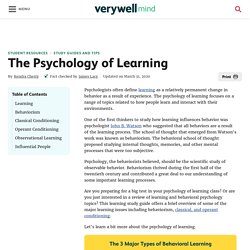
The psychology of learning focuses on a range of topics related to how people learn and interact with their environments. One of the first thinkers to study how learning influences behavior was psychologist John B. Watson who suggested that all behaviors are a result of the learning process. The school of thought that emerged from Watson's work was known as behaviorism. The behavioral school of thought proposed studying internal thoughts, memories, and other mental processes that were too subjective. What is Operant Conditioning? What Is Operant Conditioning and How Does It Work? Operant conditioning, sometimes referred to as instrumental conditioning, is a method of learning that employs rewards and punishments for behavior.
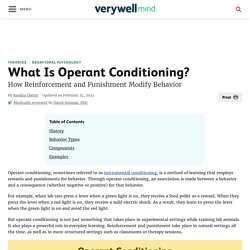
Through operant conditioning, an association is made between a behavior and a consequence (whether negative or positive) for that behavior.1 For example, when lab rats press a lever when a green light is on, they receive a food pellet as a reward. When they press the lever when a red light is on, they receive a mild electric shock. As a result, they learn to press the lever when the green light is on and avoid the red light.
But operant conditioning is not just something that takes place in experimental settings while training lab animals. What are Reinforcement and Punishment? Reinforcement & Punishment. Skinner’s Operant Conditioning: Rewards & Punishments. Use of Positive and Negative Reinforcement. Parenting A Teen Through Positive Reinforcement - Back On Track. Most parents can agree: the teenage years can be rough!

Hormones are raging, they are trying to gain more independence, and they spend a lot of time away from their parents and their home while hanging with friends. One minute they love and adore you, the next minute you ruined their life. Parenting Children with Positive Reinforcement (Examples + Charts) Children don’t come with instructions and discipline is often experienced by parents and children alike as an arena where our will and wits are tested.
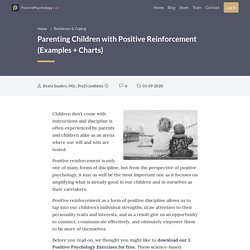
Positive reinforcement is only one of many forms of discipline, but from the perspective of positive psychology, it may as well be the most important one as it focuses on amplifying what is already good in our children and in ourselves as their caretakers. Positive reinforcement as a form of positive discipline allows us to tap into our children’s individual strengths, draw attention to their personality traits and interests, and as a result give us an opportunity to connect, communicate effectively, and ultimately empower them to be more of themselves.
Before you read on, we thought you might like to download our 3 Positive Psychology Exercises for free. Examples of Positive Reinforcement. Whether you deal with young children at home or in the classroom, or you want to be a better manager of adults in the workplace, educational psychologists have studied ways to influence people to get the results you want.
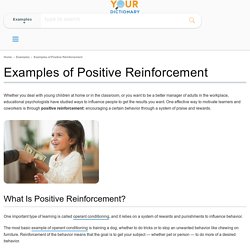
One effective way to motivate learners and coworkers is through positive reinforcement: encouraging a certain behavior through a system of praise and rewards. What Is Positive Reinforcement? One important type of learning is called operant conditioning, and it relies on a system of rewards and punishments to influence behavior. The most basic example of operant conditioning is training a dog, whether to do tricks or to stop an unwanted behavior like chewing on furniture. Examples of Negative Reinforcement. It helps to explore some examples of negative reinforcement, a concept of operant conditioning that people frequently misunderstand.

Learn what negative reinforcement is and see how it works in practice. What Negative Reinforcement Is and Is Not Negative reinforcement is about encouragement. The American Psychological Association (APA) reports that it has to do with removing a negative or unpleasant stimulus from a situation in response to someone's action. Because the negative stimulus is removed, the person or animal wants to keep doing the action that removed it. Use of Positive and Negative Punishment. Negative Punishment - Psychestudy. Punishment is an important concept used in the theory of Operant conditioning, whose main goal is to decrease the rate of certain undesired behavior from occurring again.
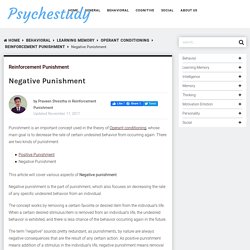
There are two kinds of punishment This article will cover various aspects of Negative punishment. How Negative Punishment Works. Negative punishment is an important concept in B.
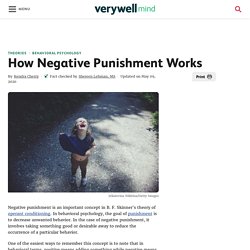
F. Skinner's theory of operant conditioning. In behavioral psychology, the goal of punishment is to decrease unwanted behavior. Real-Life Examples of Positive Punishment. “Positive” and “punishment” seem like two words that you wouldn’t use together.

However, positive punishment will make complete sense once you learn the definition and explore some examples of positive punishment. Review how positive punishment is different from negative punishment and which is more effective. Understanding Positive Punishment. Negative Punishment Examples and Scenarios. Nobody ever wants their stuff taken away.

That is the main concept behind negative punishment. Using negative punishment example scenarios, gain an understanding of the concept and its effectiveness. Then, go on to explore the difference between positive and negative punishment. Conclusion: Which approach is more effective? The Difference between Positive/Negative Reinforcement and Positive/Negative Punishment.
February 5, 2013 7:40 pm Published by Kelley Prince M.A., BCBA In Applied Behavior Analysis, there are two types of reinforcement and punishment: positive and negative. It can be difficult to distinguish between the four of these. The Use of Reinforcement and Punishment in Shaping a Child's Behavior. Rewarding behavior is key to parenting teens, study suggests. Parenting is hard, and parenting teens brings about an entirely new set of challenges, from keeping their rooms clean to getting them home before curfew.
But, a new study suggests parents who want their teenagers to keep their grades up could have better success if they focus more on rewarding good behavior and less on threatening to punish the bad. According to the report, published in PLOS Computational Biology, British researchers have found that adolescents focus well on positive incentives, but have difficulty staying motivated to avoid penalties. The study shows that teens and adults learn in different ways, according to the study’s lead author Stefano Palminteri, a researcher with the Institute of Cognitive Neuroscience at University College London. It suggests that “in some cases positive feedback may have more of an effect than negative feedback on learning” in adolescents. BYU Study: a need for positive reinforcement among teens. There are countless publications describing the best ways to raise a child in the hopes of them becoming successful adults.
Between the books, magazines and video tutorials, parents may be finding themselves overwhelmed on more than one occasion. But a group of researchers at Brigham Young University have found the answer to helping children through life may be less complicated than it seems.